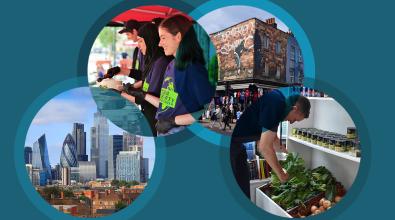Behavioral insights at 10: Lessons and new directions

Image courtesy of Shutterstock
It’s been a decade since the term “behavioral insights” entered the government innovation vocabulary. The idea was always simple: to devise public-sector programs, policies, and services based not on how we might wish people would behave, but rather, on what evidence shows us about how they actually do.
Since then, approaches based on behavioral insights have taken hold around the world, helping to boost pension enrollments in the U.K., for example, and generate more diverse recruiting pools for police departments in the U.S. to hire from.
In a new book, Michael Hallsworth and Elspeth Kirkman dive into the history of this movement and show how government practitioners can put behavioral insights to use to solve problems in new ways. The authors are veteran executives of the Behavioral Insights Team, a U.K.-based social purpose company that partners with public-sector agencies in dozens of countries, including a number of U.S. cities through Bloomberg Philanthropies’ What Works Cities initiative.
We caught up with Hallsworth to hear more about what city-hall innovators can learn from "Behavioral Insights" (MIT Press).
Why did you write this book?
It’s good to get down what we’ve been doing. Because there’s been some confusion and many questions about what this idea of behavioral insights actually is. People have been using the term, but there’s still some fuzziness.
And what do you mean by it?
There are three aspects. One is evidence about behavior — emphasizing that there’s a non-conscious or automatic aspect to our behavior that we tend to neglect and don’t think about enough.
The second thing is a practical emphasis. This is all about practical problems, not just an intellectual activity. We’re trying to get better outcomes, working within the system.
And the third aspect is trying to figure out what works — evaluating what you do. And that’s really important because behavior is complex. You don’t know what is going to work, necessarily, so it’s important to know what impact you’ve had. That’s just a good thing for organizations to be doing in general, that cycle of experimentation and learning.
Why is using behavioral insights critical to cultivating an innovative problem-solving culture in city halls?
One reason is, and you may not even realize it, but the way you’ve set up your services are dependent on people reacting a certain way. That’s quite a broad sweeping statement, but it’s basically true. People may not react the way that you assume. For example, presenting several side effects of a drug to people may make them more likely to take it than if you list just one. Given the importance of behavior, of how people react, you really should structure what you’re doing accordingly for greatest success.
A second reason is this testing and iterating approach can drive improvements in the longer term. You can get a lot of improvements fairly quickly for relatively little money through this approach. For example, we found that we could reduce no-shows for hospital appointments by just changing the wording of text-message reminders. That experiment took just a couple of months from start to finish. You can build on these experiments to find other low-cost ways of innovating and getting that feedback and improving things step-by-step.
How can behavioral insights be tapped to shape responses to COVID-19?
We’ve run rapid trials with cities on their messaging — we did 14 trials in 12 cities, most of them in partnership with What Works Cities. The cities came to us and they were faced with the challenge of how do we communicate to people most effectively to stay at home, for example, or to get across the need for social distancing or wearing a mask? And we were able to run rapid online trials and compare how different messages were likely to affect people. And then the cities could implement the most promising option really quickly.
For example, San José, Calif., came to us and really urgently wanted advice on how to communicate shelter-in-place. We tested messages in English, Spanish and Vietnamese. People were randomly assigned to see one of five different flyers on the issue. One was just a simple one that said, “Stop coronavirus. Stay home.” Another one was a duty-based message: “Stay home. It’s your duty.” One showed health professionals and stressed joining them in the fight to save lives by staying home. Another stressed that you may be home, but other people were doing the same thing. And then we tested a message with what we call an identifiable victim — “Someone you love could get sick. Protect them. Stay home.”
We assessed these different kinds of messages in different ways, including whether people remembered the main message and whether they said they were likely to stay home. And one thing we found was that actually the simple flyer (“Stop coronavirus. Stay home.”) performed best when people are asked to recall what the message was. They’ve used this in their messaging and told us, this is amazing, this has saved lives.
Many of the early applications of behavioral insights in U.S. cities have related to making communications more effective. What other areas do you see as particularly ripe for local government to put behavioral insights to work?
Thinking creatively about the built environment is important. We’ve done work on trying to reduce fatalities at traffic intersections, for example. And COVID-19 will continue to be an area of interest, when we look at how are people behaving in their environment. What are easy ways of making it simple for people to maintain social distance, and adopt new routines and habits?
Then there’s how we design services. What you see in the U.S. quite a bit is systems, like student aid forms, for example, that seem deliberately designed to be difficult to use. It’s like sludge put into the system to slow things down and impede you from accessing a service that may benefit you. There’s a big role for behavioral insights to be used to remove this sludge from the process so that people can interact with government services in a better, more efficient, and more rewarding way.
How should city leaders think about building this sort of capacity within city hall? There are cities like Scottsdale, Ariz., who have built their own in-house expertise around this. Is that the future?
There are different stages you can see cities at. The first stage is just that people in city hall are understanding that there is such a thing as behavioral science and that it could be helpful in some ways. A very baseline understanding that there is this thing, and it could be useful.
Then there’s a next stage, which is learning. That’s where cities get some experience designing or running behavioral insights projects, or applying these principles through working with experts like BIT.
Then you get to a build phase for cities, where they’re building capabilities and experience by starting to do their own things with less support, only very light-touch guidance, from the outside.
And then finally you get to where cities have developed a capacity and embedded it in their organization and culture. And you do see that in some cities like Minneapolis, which now has an evaluation team working on behavioral insights projects as well as bigger evaluations. Or Mesa, in Arizona, has also set up its own team.
It makes sense to have a dedicated resource — some people in the organization you can go to to find out more. The ultimate goal is that it’s just done more broadly throughout the organization, but we’re not there yet.
What’s next for this movement?
There’s still a lot to be done in the U.S. around the more basic applications of behavioral insights — just around the way things are set up. So while we spend a lot of time thinking of what’s the future, moving beyond nudges to bigger challenges like increasing economic mobility in the United States, there’s a lot of fairly basic stuff that will improve people’s lives that we’re not doing. And I’m still motivated to do that stuff.



